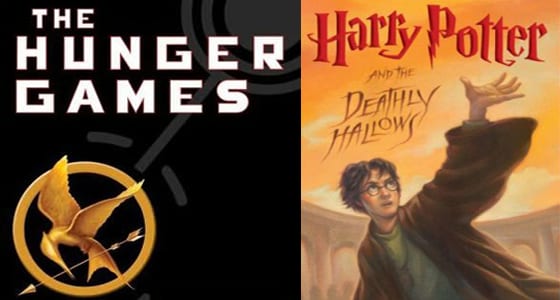Twelve-year-olds with guns and knives. Sixteen-year-olds with crossbows, and pumped-up older teens going on violent rampages. Why? Because children, ages 12 to 18, are condemned to fight one another to the death while residents of their nation watch on TV and root for the contestants that charmed them in their pre-game interviews. The last one alive is declared the “winner.”
This is the main storyline in the first two books of “The Hunger Games” trilogy, a series that my twin middle-schoolers are currently obsessed with. A series that’s now being made into films that are expected to rival the “Twilight” saga in popularity.
So what the heck did I consent to letting them read?
 On paper, the premise certainly didn’t sound anything like the “Harry Potter”series that has loomed so large in my house for several years, which features a fearless orphan boy who stood up for others, for what was right and offered to sacrifice himself to put an end to evil.
On paper, the premise certainly didn’t sound anything like the “Harry Potter”series that has loomed so large in my house for several years, which features a fearless orphan boy who stood up for others, for what was right and offered to sacrifice himself to put an end to evil.
. . or did it?
I devoured Suzanne Collins’ The Hunger Games series myself this summer, and finally figured out what my kids liked about it and how much Potter-esque DNA it actually possesses. The hero of the series is a 16-year-old girl named Katniss Everdeen who, after her father dies in a mine explosion when she’s 11, steps in and raises her 7-year-old sister Prim as their mother, overwhelmed with grief, withdrew from the world and failed to provide for her children or attempt to help them navigate the harsh conditions of the apocalyptic era in which they lived. (The series is set in “Panem,” the ruins of what used to be called North America after it was besieged by disasters, droughts, storms, fires and rising seas.)
Katniss, like Harry Potter, leads with her heart more often than her head. Emotional and sometimes reckless, she’s a loyal friend and ally and puts others ahead of herself, even if that means inserting herself into harm’s way. By page 22 of the first book, she volunteers to take the place of her then 12-year-old sister when Prim’s name is selected as the female participant in the annual, government-mandated abomination called the Hunger Games.
But let’s back up: what are the Hunger Games exactly?
A male and a female ranging in age from 12 to 18 years old are selected from each of the 12 districts of Panem, not including the Capitol. (Some children’s names have voluntarily been entered into the pool multiple times because by increasing their chances of getting picked, they can buy their family food and oil assistance in this hugely impoverished, brutally suppressed nation.) The selected Hunger Games “tributes” are brought to the Capitol, which is populated by people who enjoy opulence and excesses of food, a stark contrast to what happens in the 12 districts which encircle it. The children are forced to participate in a lethal game in a man-made arena filled with hazards and loaded with TV cameras so everyone in the districts and the Capitol can watch until only one “tribute” is left with a pulse. Why does the Capitol dictatorship do this? As punishment for a previous political uprising and to remind the districts of who is in charge.
Just some light, cheery reading, eh?
 The adults in the Hunger Games series don’t come off very well, like many of the adults in the Potter series (those in the Ministry of Magic, the disciples of the super-evil Voldemort, and those who called Harry a fraud and a liar are just a few examples). Aside from the fact that the residents of the districts allow their children to be sacrificed year after year and the fact that those running the Panem government find this barbaric “feed-em-to-the-lions” mentality acceptable, there are the vapid residents who live in the Capitol who also go along with the concept of the Hunger Games as if it is some kind of pageant on speed, a mere justification to party while those in the poor districts struggle to nourish themselves as they watch their children die.
The adults in the Hunger Games series don’t come off very well, like many of the adults in the Potter series (those in the Ministry of Magic, the disciples of the super-evil Voldemort, and those who called Harry a fraud and a liar are just a few examples). Aside from the fact that the residents of the districts allow their children to be sacrificed year after year and the fact that those running the Panem government find this barbaric “feed-em-to-the-lions” mentality acceptable, there are the vapid residents who live in the Capitol who also go along with the concept of the Hunger Games as if it is some kind of pageant on speed, a mere justification to party while those in the poor districts struggle to nourish themselves as they watch their children die.
Parents disappoint their children as well. In addition to Katniss’ emotionally AWOL mother, the male Hunger Games participant from Katniss’ District 12, Peeta Mellark has a wretched mother who, when faced with a starving 11-year-old girl in her neighborhood (a younger Katniss) chooses to feed burned loaves of bread to livestock rather than to Katniss. All the tributes who are forced to participate in the Hunger Games want is for their parents to protect, feed and shelter them. But they don’t, or can’t, so the children wind up fending for themselves and protecting one another. And although the professors at the Hogwarts School of Wizardry and Witchcraft provided guidance to Harry Potter and his friends Ron and Hermione, it is the children who get the ultimate burden of saving the day – just like Katniss and her pal Peeta in the Hunger Games series.
While The Hunger Games is much darker and more appallingly sinister than the world J.K. Rowling created, it has a similar child hero in the form of a poor, super-thin girl with a huge heart, a hot temper and nothing to lose. I think Harry and Katniss would get along swimmingly.
After I finished reading the final installment of the trilogy, what did I make of my kids’ adoration for the series that has been a best-seller on the New York Times’ children’s list for more than a year? That they want to feel powerful, to see good defeat evil and that, in comparison to Katniss, my kids live lives of luxury. However whenever I say, “There are starving kids in District 12” as a means to try to get them to eat their dinner, that’s where their admiration for the books and pity for Katniss ends.
It doesn’t yield appreciation, just a roll of the eyes. You can’t blame me for trying.





